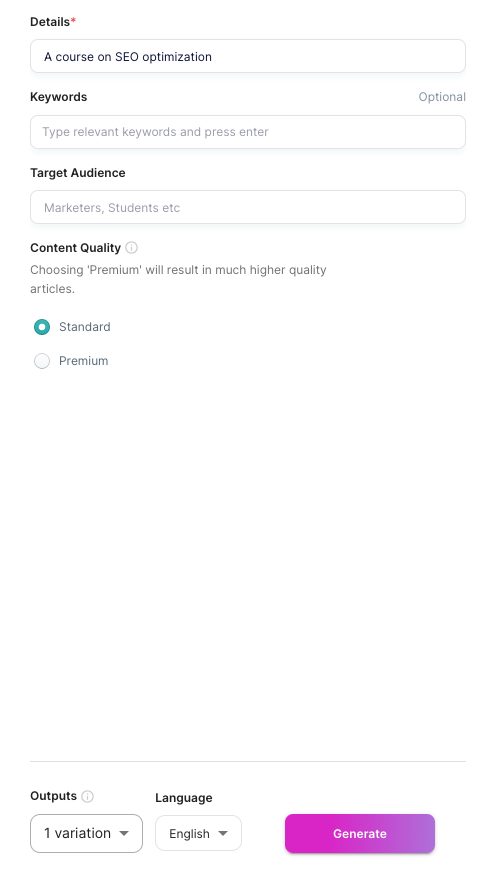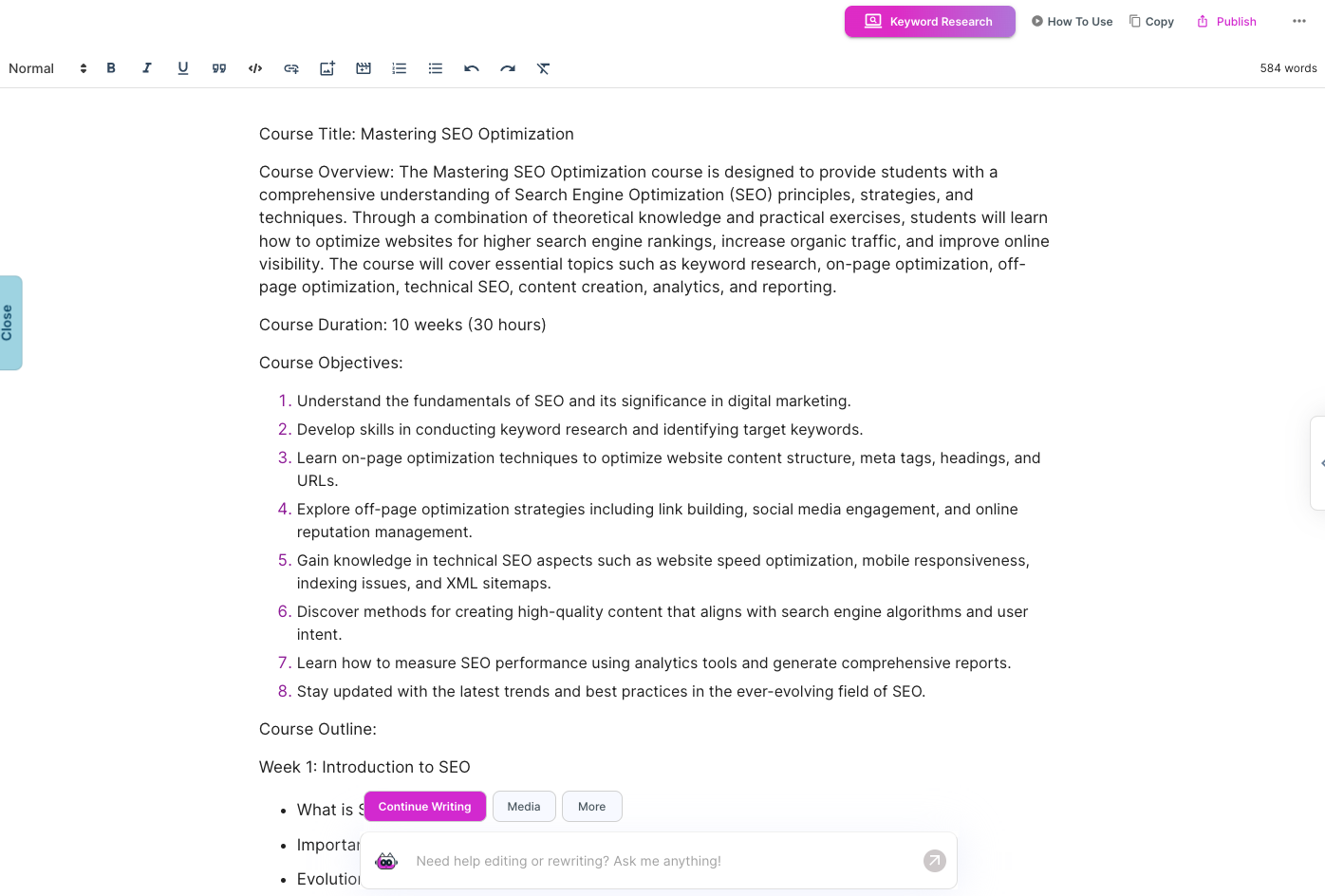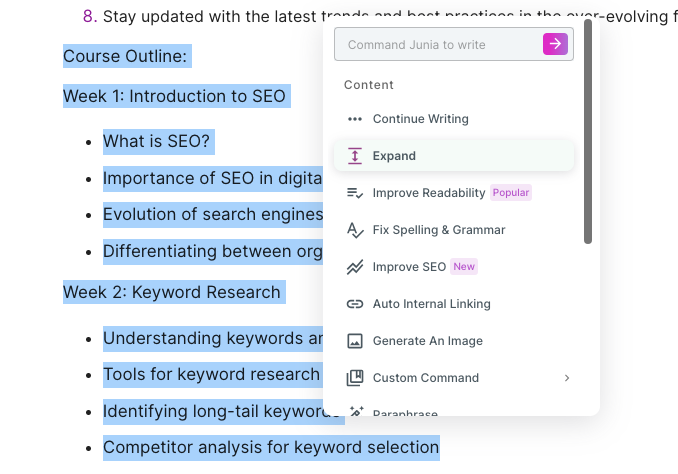Course Curriculum/Outline Generator
A course curriculum and outline are important parts of an educational program. They show educators how to teach effectively and make sure students have a complete learning experience. Junia AI's Course Curriculum/Outline Generator is a helpful tool that uses AI to streamline such a complex process and make curriculum planning easier.
Creating a course that meets specific educational needs usually requires a lot of time and resources. Junia AI solves this problem by providing an innovative solution that automates the process of generating personalized course outlines.
Junia AI's Course Curriculum/Outline Generator offers educators:
- A quick way to create detailed course outlines
- The ability to customize content in alignment with unique course goals
- An efficient workflow, enhancing productivity
Using advanced AI technology, Junia AI makes sure that educators can focus on providing high-quality education instead of getting caught up in the complexities of curriculum design.
Understanding Course Curriculum and Outline
The term course curriculum refers to the academic content conveyed within a course, including the learning objectives, instructional strategies, and assessment methods. It serves as a comprehensive guide for educators to impart knowledge and skills effectively to their students. The significance of a well-developed course curriculum cannot be overstated—it sets the foundation for student engagement and achievement.
A course outline, on the other hand, is a detailed plan that outlines the topics, objectives, and activities for each session or module within the course. It acts as a roadmap for both instructors and students, ensuring that everyone is aware of what is expected throughout the learning journey.
When designing a course outline, you should include:
- Course Objectives: Clearly defined goals that students are expected to achieve by the end of the course.
- Module Breakdown: A chronological list of topics covered in each module or session.
- Instructional Activities: Engaging tasks and projects facilitating hands-on learning experiences.
- Resources Needed: Textbooks, software tools, or other materials required for successful completion of the course.
- Assessment Methods: Various forms of evaluations such as quizzes, assignments, exams, or practical applications that measure student understanding.
By establishing a clear framework through a course curriculum and outline, educators can create an environment conducive to learning while providing students with clear expectations and pathways to success.
Advantages of Using an AI-powered Course Curriculum Generator
Educators and course designers have the responsibility of creating comprehensive curricula that meet the needs of various learning goals. In this situation, an **AI-powered **content generator tool like a Course curriculum generator is not just a luxury but a necessity for modern educational environments.
Benefits of Using Technology for Curriculum Development
Here are some advantages of using an AI-powered Course Curriculum Generator:
- Efficiency: AI algorithms analyze large amounts of data, identify patterns, and suggest content that aligns with the course's objectives.
- Consistency: Ensures that all modules and lessons are consistent with each other, which is important for a smooth learning experience.
- Personalization: Tailors the curriculum to individual learner needs by taking into account different learning styles and preferences.
- Scalability: Whether you're creating a course for ten students or a thousand, an AI-powered generator can handle the workload without compromising quality.
Saving Time and Effort
Using an AI-powered Course Curriculum Generator can save educators a significant amount of time:
- Automated Outline Creation: Instead of starting from scratch, you receive a suggested structure that you can modify as needed.
- Resource Integration: It recommends relevant materials and resources, reducing the time spent on research.
This approach not only simplifies the development process but also allows educators to spend more time engaging with students and less time on administrative tasks.
Features and Functionalities Of Junia AI's Course Curriculum/Outline Generator:
- Automated Outline Creation: Simply enter your course title and description, and Junia AI will generate a structured outline for your curriculum.
- Customization Capabilities: Tailor the generated outline to your course by easily adjusting module titles and lesson sequencing.
By utilizing these features, educators can efficiently create a comprehensive course curriculum that aligns with their teaching approach and caters to the diverse learning styles of their students. With Junia AI's Course Curriculum/Outline Generator, you can focus more on the art of teaching itself rather than getting caught up in the logistics of outline creation.
The Process of Creating a Course Outline with Junia AI's Generator
Creating an effective course curriculum is a nuanced process that requires careful consideration and planning. Junia AI's Course Curriculum/Outline Generator simplifies this process with its intuitive workflow. Educators can craft a comprehensive course structure by following these steps:
Step 1: Entering the Course Details

You begin by providing the essential information about your course. This includes the course title, a detailed description, and any specific learning objectives you have in mind. These details lay the groundwork for a tailored curriculum that aligns with your educational goals.
Step 2: Generating the Initial Outline

Once you've inputted the basic details, Junia AI's generator uses this data to produce an initial course outline. The AI algorithm crafts a structured framework consisting of modules and potential lesson topics that correspond with your provided information, giving you a solid starting point.
Step 3: Refining the Outline Structure

The generated outline serves as a preliminary draft that you can sculpt to perfection. At this stage, you have the opportunity to adjust module sequences, add or remove topics, and ensure each segment of the course flows logically into the next with Junia AI's text editor. This step is vital for creating an organized and coherent learning pathway for your students.
By following these three steps within Junia AI's tool, educators can develop a robust curriculum foundation quickly, allowing more time to focus on creating rich content and engaging learning experiences.
